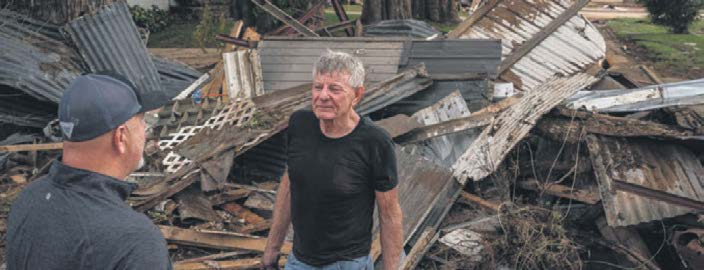
By Zach Montague and Jacey Fortin
On Wednesday, President Joe Biden conducted an aerial inspection of the destruction caused by Hurricane Helene and instructed the Pentagon to send up to 1,000 active-duty personnel to help with relief operations as rescue crews continued perilous missions in isolated mountain regions.
Biden’s trip to the Carolinas occurred as the storm’s death toll exceeded 175 on Wednesday, making Helene the most lethal hurricane to hit the continental United States since Katrina, which resulted in nearly 1,400 fatalities in 2005, based on data from the National Hurricane Center.
Alejandro Mayorkas, the Secretary of Homeland Security, informed reporters accompanying the president that the expensive relief initiative could rapidly deplete much of the Federal Emergency Management Agency’s budget for the remainder of the year, leaving the agency ill-equipped for another significant disaster this season unless Congress returns from its break to approve additional funds.
“We are addressing immediate requirements with the resources available,” Mayorkas stated to journalists. “We’re anticipating another hurricane approaching — we lack the resources, and FEMA lacks the resources, to navigate through the season.”
On Wednesday, Speaker Mike Johnson, R-La., indicated that lawmakers would not reconvene in Washington prior to the November election to deliberate on an emergency funding package.
“We couldn’t even remotely have the request prepared before we return in November,” Johnson remarked in an interview, emphasizing that assessing the damage and estimating recovery and rebuilding costs would take time. “There’s no urgency for Congress to reconvene.”
After a brief meeting with a group of officials in South Carolina, including Sen. Lindsey Graham and Gov. Henry McMaster, Biden observed some of the hardest-hit areas of North Carolina from the air while rescue teams operated below. He flew over Asheville and Lake Lure, North Carolina, with Governor Roy Cooper and Asheville’s Mayor, Esther Manheimer.
The choice to view the scene from the air was influenced by the severe conditions on the ground, where over 1,200 personnel from FEMA and various agencies were still searching for survivors and rushing to deliver food and fuel, Mayorkas told the press.
“What he wants to avoid is in any way hindering or obstructing the rescue efforts we are conducting,” he stated.
While the president surveyed the destruction in North Carolina, Vice President Kamala Harris visited the Augusta Emergency Operations Center in Georgia to express gratitude to a group of emergency medical professionals assembled there.
“You undertake this work in these critical moments, tirelessly, with an intention and a level of care and compassion for the community that is unparalleled,” Harris addressed the group.
Biden is scheduled to meet with officials in Florida and Georgia on Thursday.
The scale of the destruction throughout the Southeast was still being uncovered nearly a week after Helene made landfall on Florida’s Gulf Coast. In the mountainous regions of southern Appalachia, numerous residents continue to be cut off by muddy debris and ruined roadways.
Despite the severe damage in parts of Florida, many of the areas most affected are hundreds of miles away from any coastline. Flooding and landslides have rendered roadways unusable, transformed downtowns into abandoned areas, and left entire neighborhoods as heaps of debris.
Malfunctioning water systems, downed electrical lines, and poor cellphone coverage are hindering rescue and recovery initiatives. The active-duty personnel Biden is sending from Fort Liberty in Fayetteville, North Carolina, will join over 6,000 National Guard members and 4,800 federal aid workers already deployed across the devastated regions of the Southeast.
At least 183 individuals in six states, from Florida to Tennessee, have perished due to the hurricane, and officials have indicated that the number of missing persons remains uncertain.
Numerous emergency responders, including volunteer organizations like World Central Kitchen and the Salvation Army, have been working tirelessly to clear blocked roads and navigate through — or above — soggy debris to distribute food and water, utilizing airdrops from helicopters and cargo planes.
In Asheville, a rapidly growing city nestled in the Blue Ridge Mountains, access to water continues to be a significant challenge. The University of North Carolina Asheville has been without power, water, and internet service since the previous week, and the institution announced on Tuesday that classes will not resume until the end of the month.
More than 1 million electricity customers, from Florida to West Virginia, remained without power as of Wednesday morning, according to the tracking site PowerOutage.us.
While state officials across the Southeast maintain focus on immediate needs, such as search-and-rescue operations and road restoration, they have also indicated that there will be no swift resolution for the region.
“This disaster is unprecedented in our state’s history,” remarked William Ray, North Carolina’s emergency management director.
